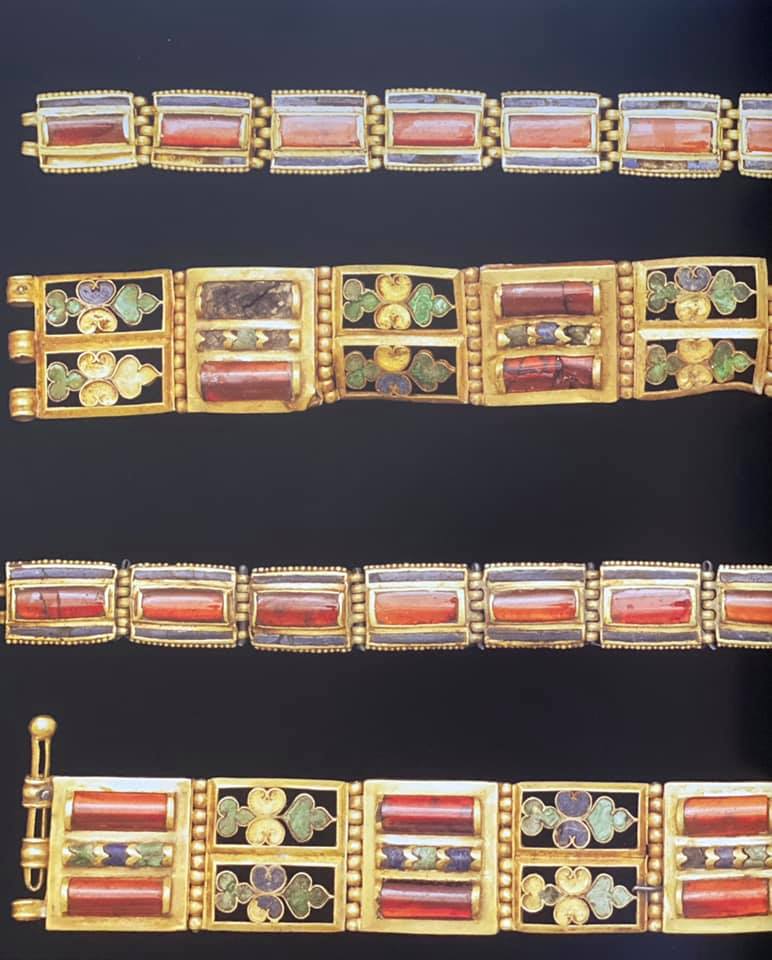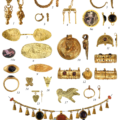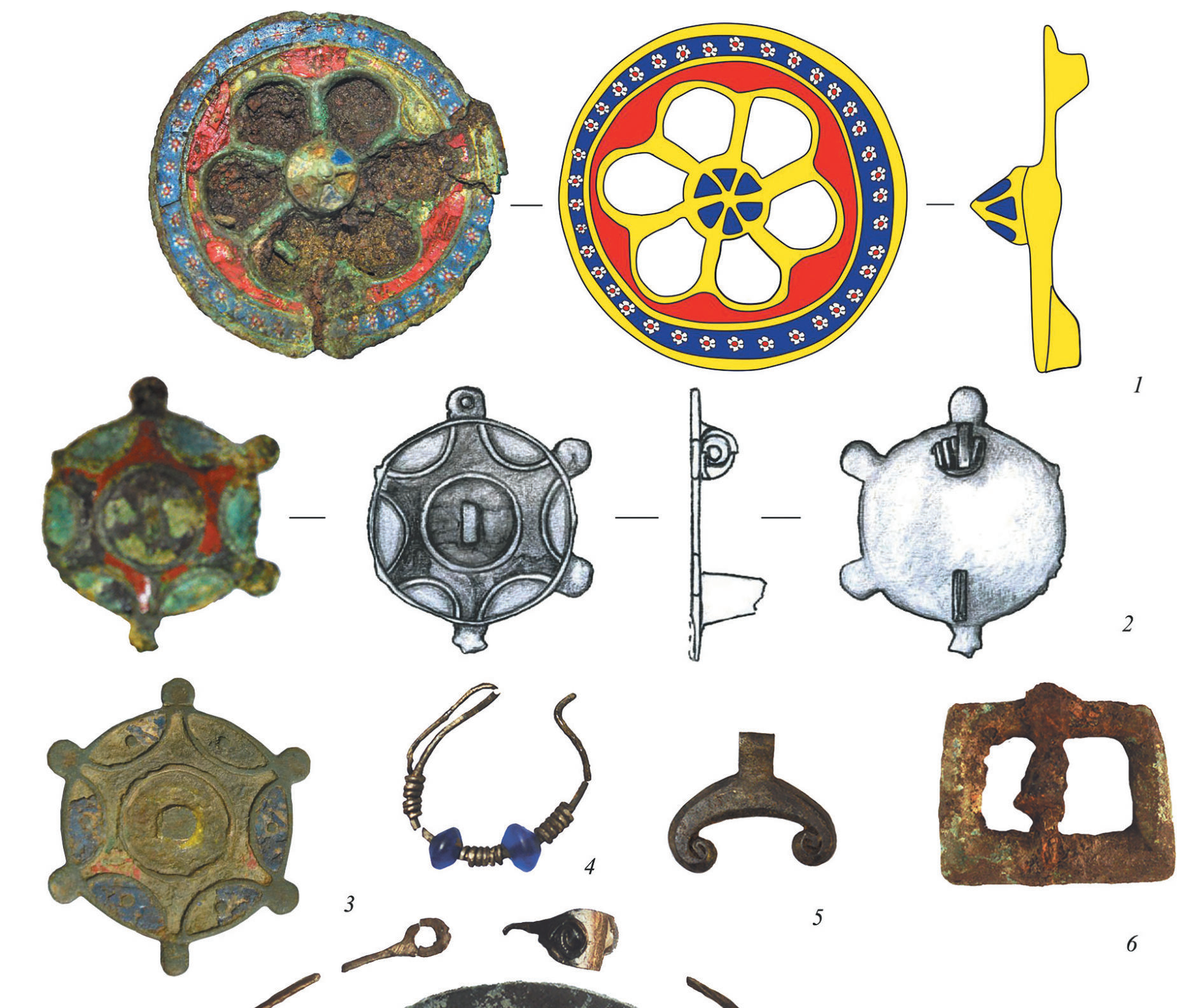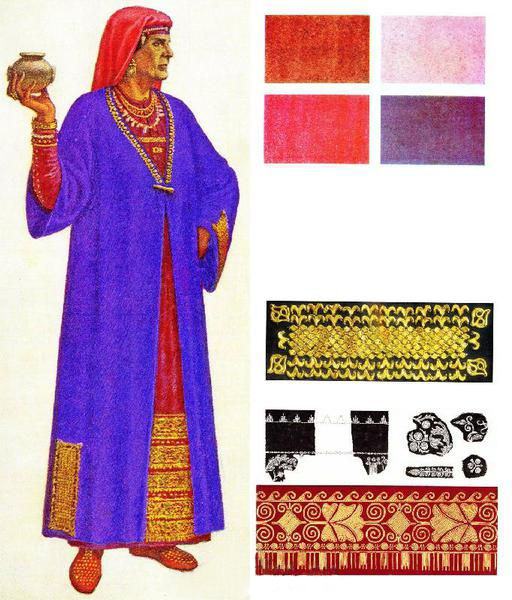In 2001, at the north-east wall of Svetitskhoveli cathedral in Mtskheta (capital of Caucasian Iberia 3rd century BCE-5th century CE), a rich burial of a woman aged 40–50 (Tomb nr 14) was discovered. A burial is dated from the late 3rd or early 4th century CE.


“A gold signet-ring with a carnelian gem-intaglio, found near the left hand of the body. The bezel is ovoid and figured. A pair of cast gold panthers is welded to the hoop, holding in their teeth and paws a hammered bezel of gold sheet. A reddish carnelian intaglio represents the left profile of a female bust encircled with a Greek inscription BACIΛICCA/OYΛΠΗANAΞΗA [Queen Ulpia the Ruler].
Height of ring – 19 mm; width – 17 mm. Length of gem – 20 mm; width – 17 mm. Total weight – 9.89 g.” [Rich burial from Mtskheta]
For the interpretation of the inscription see an article by Eka Avaliani, Finding Meaning in the Past: Reinterpretation of the Late Roman Artifact, the Golden Ring with a Carnelian Intaglio from the Museum of Georgia https://www.academia.edu
Photo source http://arqivi.mmcsiu.com/files/mcxetis%20informacia.pdf
[see below the PDF file attached to this post]
Among the grave goods are three similar-shaped ovoid gold pendants with high relief busts: a female one, made of chalcedony with a carnelian coiffure, and two carnelian busts of boys. They are described in the article Rich burial from Mtskheta:
1.bust of a woman [Inv. No. 01-6-X-1616]
“A gold pendant. An ovoid brooch is set with a chalcedony relief bust of a lady wearing a gold necklace. She is dressed in a chiton(?). Her carnelian coiffure is flattened on the back of her head. She has a straight, prominent nose, thick lips and a chin jutting out a little. Found near the pelvis. Height – 27 mm; width – 16 mm; diameter of brooch – 15-16 mm. A similar pendant, but with a male bust, was found at Mtskheta Baiatkhevi cemetery, in tile burial No. 35, dated to the 3rd century AD.”


[see below the PDF file attached to this post]
2. bust of a boy no 1 [Inv. No. 01-6-X-1617]
“A gold pendant. An ovoid brooch of false-rope design with a tang, set into which is a carnelian bust of a boy wearing a gold necklace. The forehead recedes, the nose a little snub, the lips thick and the cheeks plump, the chin juts out a little, and the boy’s hair, divided into five parts, is plaited. Found near the pelvis. Height – 12 mm; width – 12 mm; weight – 1.68 g. The bust is a fine piece of perfectly sculpted relief work. A similar gem, but set in a finger-ring, has been found at Mtskheta, Samtavro burial No. 905.”
3. bust of a boy no 2 [Inv. No. 01-6-X-1618]
“A gold pendant, similar to No. 1. Its rear surface is slightly damaged. The boy is adorned with an impressed, crisscross garland around the neck. The bust is encircled by a pair of grooves. Height – 12 mm; width – 12 mm; weight – 1.70 g.”
Writing set




https://www.facebook.com/GNMuseum/photos/pcb.10157381669581269/10157381659776269


- A. Apakidze, G. Kipiani and V. Nikolaishvili (Tbilisi), Rich burial from Mtskheta (Caucasian Iberia), in: Ancient West East, Volume 3, No 1 (2004) ed. Gocha R. Tsetskhladze, pp. 104-123
- ARCHAEOLOGY OF THE ROMAN PERIOD OF GEORGIA (Iberia-Colchis) by Gela Gamkrelidze (Essay & Catalog). Tb. 2014 https://www.academia.edu
- http://arqivi.mmcsiu.com/files/mcxetis%20informacia.pdf [see below the PDF file attached to this post]
- The Mtskheta Institute of Archeology of the Georgian Academy of Sciences, an article [website does not exist anymore]
- http://museum.ge/index.php?lang_id=ENG&sec_id=121&info_id=996
- Picture from the Museum of Georgia https://angi.ge/simon-janashias-saxelobis-saqartvelos-muzeumi/












